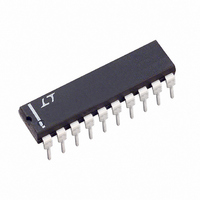LTC1289CCN Linear Technology, LTC1289CCN Datasheet - Page 20

LTC1289CCN
Manufacturer Part Number
LTC1289CCN
Description
IC DATA ACQ SYS 12BIT 3V 20-DIP
Manufacturer
Linear Technology
Type
Data Acquisition System (DAS)r
Datasheet
1.LTC1289CCN.pdf
(28 pages)
Specifications of LTC1289CCN
Resolution (bits)
12 b
Sampling Rate (per Second)
25k
Data Interface
Serial, Parallel
Voltage Supply Source
Dual ±
Voltage - Supply
3V
Operating Temperature
0°C ~ 70°C
Mounting Type
Through Hole
Package / Case
20-DIP (0.300", 7.62mm)
Lead Free Status / RoHS Status
Contains lead / RoHS non-compliant
Available stocks
Company
Part Number
Manufacturer
Quantity
Price
Company:
Part Number:
LTC1289CCN
Manufacturer:
Epson
Quantity:
6 029
LTC1289
2. It is recommended that REF
6. Reduced Reference Operation
The effective resolution of the LTC1289 can be increased
by reducing the input span of the converter. The LTC1289
exhibits good linearity and gain over a wide range of
reference voltages (see typical curves of Linearity and Gain
Error vs Reference Voltage). However, care must be taken
when operating at low values of V
reduced LSB step size and the resulting higher accuracy
requirement placed on the converter. The following factors
must be considered when operating at low V
1. Offset
2. Noise
20
A
PPLICATI
Figure 16. Poor Reference Settling Can Cause A/D Errors
the analog ground plane. If REF
other than ground, the voltage must not change during
a conversion cycle. This voltage must also be free of
noise and ripple with respect to analog ground.
Figure 15. Adequate Reference Settling
O
U
HORIZONTAL: 1µs/DIV
HORIZONTAL: 1µs/DIV
S
I FOR ATIO
U
–
input be tied directly to
–
is biased at a voltage
W
REF
because of the
REF
U
values:
Offset with Reduced V
The offset of the LTC1289 has a larger effect on the output
code when the A/D is operated with reduced reference
voltage. The offset (which is typically a fixed voltage)
becomes a larger fraction of an LSB as the size of the LSB
is reduced. The typical curve of Unadjusted Offset Error vs
Reference Voltage shows how offset in LSBs is related to
reference voltage for a typical value of V
a V
becomes 0.4LSB with a 1.25V reference. If this offset is
unacceptable, it can be corrected digitally by the receiving
system or by offsetting the “–” input to the LTC1289.
Noise with Reduced V
The total input referred noise of the LTC1289 can be
reduced to approximately 200µV peak-to-peak using a
ground plane, good bypassing, good layout techniques
and minimizing noise on the reference inputs. This noise
is insignificant with a 2.5V reference but will become a
larger fraction of an LSB as the size of the LSB is reduced.
The typical curve of Noise Error vs Reference Voltage
shows the LSB contribution of this 200µV of noise.
For operation with a 2.5 reference, the 200µV noise is only
0.32LSB peak-to-peak. In this case, the LTC1289 noise
will contribute virtually no uncertainty to the output code.
However, for reduced references, the noise may become
a significant fraction of an LSB and cause undesirable jitter
in the output code. For example, with a 1.25V reference,
this same 200µV noise is 0.64LSB peak-to-peak. This will
reduce the range of input voltages over which a stable
output code can be achieved by 0.64LSB. In this case
averaging readings may be necessary.
This noise data was taken in a very clean setup. Any setup
induced noise (noise or ripple on V
add to the internal noise. The lower the reference voltage
to be used, the more critical it becomes to have a clean,
noise-free setup.
OS
of 0.1mV which is 0.2LSB with a 2.5V reference
REF
REF
CC
, V
REF
OS
, V
. For example,
IN
or V
–
) will
1289fb














